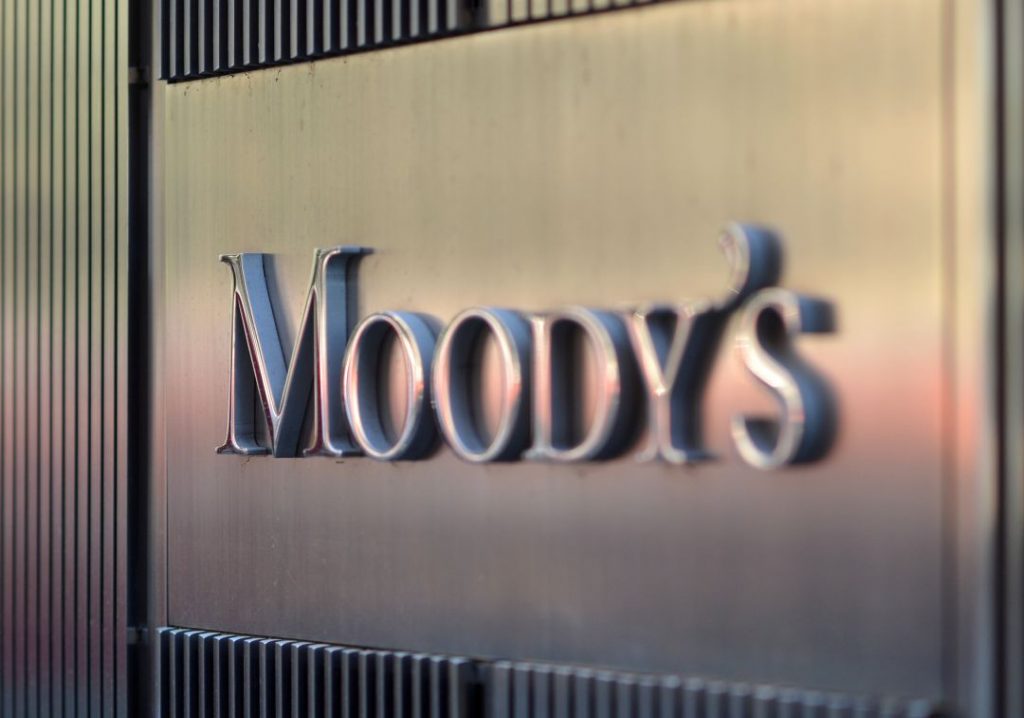The international ratings agency, Moody’s, has retained Ghana’s B3 long-term issuer ratings with negative outlook it set earlier this year. The retention of the negative outlook, which it had downgraded from stable six months ago, means it still suspects the economic trajectory with regards to sovereign credit worthiness is downward for now.
The timing of the latest rating is inconvenient for the Government of Ghana as it contemplates doing another bond issuance on the international capital markets, of about US$1.5 billion, before the end of the year. While Moody’s less than upbeat assessment will not prevent Ghana from attracting the patronage of international bond investors, it will encourage them to demand a premium with regards to the coupon interest rate that will be applicable on the issue.
This is ironic in that a major reason why Moody’s has refused to improve its assessment of Ghana’s sovereign credit worthiness is that the country’s debt burden is already inordinately high; but the consequent assessment has created the grounds for that burden to rise much further, much faster than if the rating had been more favourable, as rising coupon rates will translate into rising debt servicing costs.
An even bigger irony is that Moody’s also points to “ ongoing liquidity challenges” as another reason for its refusal to upgrade Ghana’s ranking; but its assessment will make refinancing of its public debt – the primary cause of those liquidity problems – all the more difficult to overcome, by constraining the attractiveness of a new bond issuance that would be used to restructure the impending major public debt maturities and thus smoothen the country’s cash flows over the short to medium term.
It is instructive that the planned new issue would be used primarily for public debt re-profiling, since, according to Finance Minister Ken Ofori-Atta, the 2021 budget is already fully financed. The need for the planned new issue arises simply because at government’s most recent Eurobond issuance, done in March this year, it elected to only take US$3 billion out of the US$6 billion it was offered, because it felt that the pricing on the other offers was prohibitively high.
Government had originally planned to take as much as US$5 billion off the market – albeit on condition that the pricing was acceptable – with two thirds of this going into debt restructuring. Having taken only 60 percent of that amount, the debt re-profiling it was able to do was much less than planned even as maturities on the series of Eurobonds issued by successive administrations since 2013 are about to commence, starting from September 2022.
According to Moody’s, the B3 rating and negative outlook reflect Ghana’s high debt burden that is unlikely to fall rapidly, continued weak debt affordability, high gross borrowing requirements and ongoing liquidity challenges in the face of downside economic, social and financial risks in the aftermath of the coronavirus pandemic.
Conversely though, the rating’s retention also takes into account improving growth prospects, resilient external sector performance and the country’s continued access to domestic and international capital markets, supported by the government’s structural economic reform agenda to improve export competitiveness and broaden the revenue base.
Moody’s said “Ghana’s credit profile is characterized by large gross borrowing requirements that exceed 20% of GDP, as well as persistent weak debt affordability stemming from interest payments rising to over 40% of revenue — both of which are among the weakest of sovereigns rated by Moody’s, underpinning its exposure to potential funding shocks.”
Furthermore, it said “both long-standing credit characteristics are the result of a high debt burden financed at relatively high costs and relatively short maturities. These vulnerabilities have been exacerbated by the pandemic.
Indeed, Ghana’s 2021 budget projects that debt servicing will take up 49.5 percent of its total tax revenues. Just as troubling, public sector wages are taking up most of the rest. Although government has succeeded in lowering its debt servicing costs during the first half of the year, due to falling interest rates on the domestic bond market, the sharp acceleration in economic growth during the second quarter of the year, to 8.9 percent has caused rising inflation and a resumption of cedi depreciation to accompany it.
Consequently, there is very little prospects of further reductions in domestic interest rates for the rest of this year, even as pressure mounts on the United States Federal Reserve Bank to increase interest rates of federal funds, as inflation begins to rise in that country, which in turn would increase Ghana’s foreign borrowing costs. This means that if Ghana sees the need to do another international bond issue, sooner would be better than later.
According to Moody’s Ghana’s fiscal deficit widened to 13.9% of GDP in 2020 (inclusive of costs associated with the financial sector clean-up, legacy energy debts and “take or pay” energy contracts), pushing the debt burden beyond 80% of GDP, from 62.6% in 2019.
This however may be disputed by the Government of Ghana, which includes both items in its public debt build up but not in its fiscal deficit computations. It argues that the cost of the financial sector cleanup is a one-off issue which does not form part of its usual fiscal activities; and that the cost of servicing the energy sector legacy debts are being taken care of automatically by a special purpose vehicle (ESLA Plc) which gets the monies to do so from certain dedicated taxes and levies, thus meaning the energy debts are effectively self-amortizing.
Indeed going by government’s own computations, 2020’s fiscal deficit was 11.9 percent and the public debt to GDP ratio is about 77 percent, both figures significantly lower – and therefore better – than those used by Moody’s. But the International Monetary Fund disagrees with government’s stance on the issue pointing out that the lower figures do a disservice by understating government’s fiscal deficit financing needs. Some local economists and public policy commentators agree, on the basis that those categories of public debt can no longer be realistically classified as one off, since they have been in play for the past four years.
While government’s political opponents see its stance as one aimed at accumulating political capital by presenting a better picture of economic management performance than is actually deserved, neutral observers rather see it as a deliberate, pragmatic gambit to lower Ghana’s debt servicing costs and improve access to debt financing by presenting less worrying fiscal deficit and public indebtedness figures than is actually the case.
But with neither the IMF nor credit ratings agencies such as Moody’s being taken in, the positive impact of the strategy is waning as potential bond investors are increasingly guided by the higher figures those institutions are computing.
The ratings agency says while the government’s most recent budget sets out a plan of fiscal consolidation to reduce the fiscal deficit to 4.8% of GDP by 2024, the longer-term economic and social scarring from the coronavirus shock presents significant challenges to achieving such ambitious targets. Moody’s also assumes that the pace of consolidation will be slower, leaving the debt burden above 80% of GDP for the foreseeable future.
These assumptions are not necessarily true though. The President Nana Akufo-Addo administration is now in its second and final term in office and so can afford to be less politically sensitive than it was between 2017 and 2020; the president is now more concerned about his economic legacy than about short term voter sentiment.
This means he will be more willing to take hard decisions than hitherto, a simple illustration being the sharp difference between government’s largesse to the populace in response to COVID 19, in the run up to the 2020 general elections; and its fiscal tightening since winning that election which indeed has led to protests on the streets of Accra. Crucially, during its first term the incumbent government had put in place the structures and processes requisite to bring the huge informal sector into the income tax net for the first time in Ghana’s well over six decade history. Having restrained from commencing the implementation ahead of the recent general elections, it has now begun to do so with the potential to dramatically increase tax revenues, thus raising Ghana’s inordinately low tax revenue to GDP ratio of about 12 percent closer to the 25 percent average for middle income countries.
But apart from better balancing the recurrent aspects of Ghana’s budget, Moody’s also frets about the challenges posed by the impending maturities on the series of Eurobonds the country has issued since 2013. While outright amortization is totally out of the question, even refinancing them will be challenging.
“In the meantime, Ghana will increasingly rely on domestic and international bond issuance to meet deficit financing requirements and Eurobond maturities starting 2023 and rising to $1 billion per year 2025-2027, leaving the sovereign exposed to a potential unfavorable turn in investor confidence”, it added.
But Moody’s admits that the downside risks notwithstanding, Ghana’s credit profile benefits from strong economic growth potential. It is instructive that Ghana’s COVID 19 imposed economic recession only lasted two quarters (the 2nsd and 3rd quarters of 2020) and has been replaced by accelerated growth. It therefore expects GDP growth to rise towards 6% in 2022 and stay around these rates in the medium term — in the absence of new shocks.
Firstly it is possible that the 6 percent medium term growth may be exceeded, if the 2021 2nd quarter growth rate of 8.9 percent is anything to go by. Secondly, none of the dynamics in the international commodity markets for Ghana’s three most important exports – crude oil, gold and cocoa – show clear signs of an impending price crash. Indeed oil prices are expected to rise further while gold prices expected to stabilize at well over US$1,600 an ounce even as monetary easing is gradually reduced worldwide. Only cocoa prices are under threat, due to over-supply and Ghana is acutely aware of this and is aggressively seeking to raise its local processing capacity.
Meanwhile, Moody‘s also notes that Ghana’s external position which has been a credit weakness in the past, has remained relatively stable through the pandemic, denoting greater resilience.
“The current account deficit was stable last year at 2.6% of GDP. Assuming steady commodity prices, Moody’s expects the deficit to remain relatively narrow around 3% of GDP”, it said.
“Foreign exchange reserves, at four months of imports cover, have been bolstered by the recent eurobond issuance and gold and cocoa production that continues to perform well. Coupled with the ramping up of oil and gas production from the Pecan field, export prospects remain favorable”, it added.
“Ghana also has a track record of political stability and relatively sound institutional and governance frameworks compared to peers, most recently demonstrated in the peaceful elections in late 2020 and continued implementation of the economic reform agenda to improve export competitiveness and broaden the revenue base”, it continued.
However, Moody’s ranks Ghana’s ESG Credit Impact Score as highly negative, reflecting its high exposure to social risks. Here, the #Fix the country protests play a prominent role. However government has refused to retreat to populist policies to avert the protests, opting instead to seek solutions that improve economic growth capacity and by so doing expand economic opportunities for the youth who are leading the protests.
However Moody’s insists that resilience to environmental and social risks is weak, constrained by low wealth and high debt levels and this adds to the reasons why it has refused to upgrade Ghana’s rankings.
With the two other sovereign ratings agencies that track Ghana – Fitch and Standard & Poors expected to announce similar assessments over the coming months, this means Ghana will face major pricing difficulties as it contemplates a further international bond issuance before the end of the year. This prevented Ghana from fulfilling all its needs at bits most recent Eurobond issuance done in March and there is thus the possibility that history may repeat itself.
This time around Ghana plans a change of tactic, by issuing Green Bonds rather than conventional Eurobonds. Ostensibly this would generate favourable sentiment from environment-sensitive bond investors and would impress the rest of the international investment community for its innovativeness – no sub Saharan African country has issued Green Binds so far.
However with the bonds meant primarily to re-profile Ghana’s public debt, many investors will not be easily taken in; the issuance would not be done to finance environmentally friendly projects and this would be clear to most of them.
However, overall, Ghana performs better than many other Sub Saharan African peers, and this will count positively for investors seeking to diversify their portfolios by including bonds issued by an African country.
Moody’s assessment is accurate in the main, but under the peculiar circumstances could have been more forgiving. Rather, it will actually intensify the shortcomings it has identified in Ghana’s financial position.
Nevertheless, it will not significantly damage the 15 year love affair between Ghana and the international bond investment community







